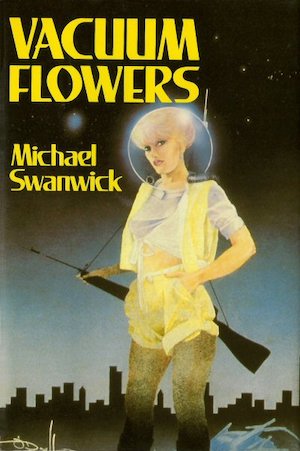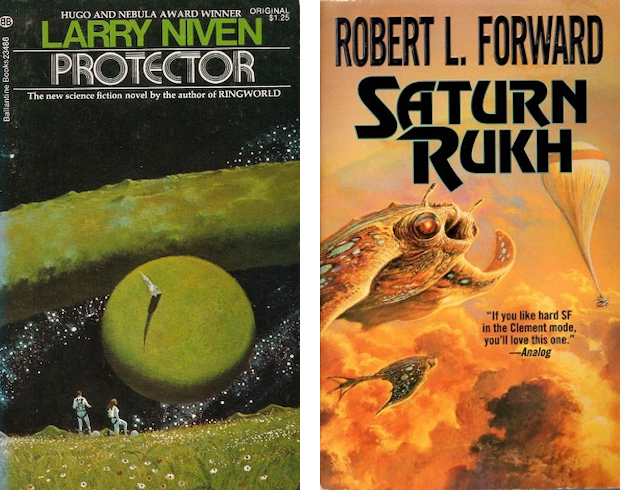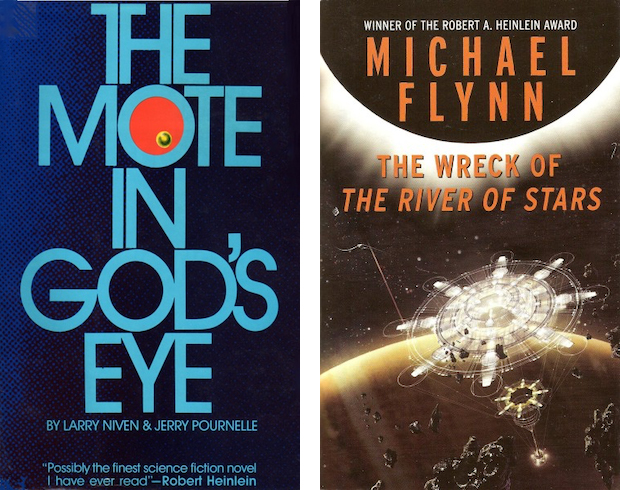Suppose one is a science fiction writer; further suppose that one wishes to depict delivery of a payload from point A to a point B across the vast gulfs of space. The obvious solution is to put the payload into a rocket. That’s not the only solution, however, and often it’s not the most appropriate one. Here are five somewhat plausible alternatives that authors have used to sidestep the inherent limitations of rockets. (I have previously discussed convenient wormhole networks. Consider it done. Or possibly due for a revisit.)
Everyone is familiar with slings. Rotating structures in space can be used to impart momentum to payloads in much the same way. (The rotating object, having shed some momentum, would need to be sped up again; handwave an energy source). Depending on one’s assumptions about tensile strengths, one might be able lob payloads across the Solar System in long, slow orbits.
Although one could imagine all manner of scenarios in which slings (AKA tethers) might play a role in SF novels, generally they don’t. The most significant novel exploiting tether momentum transfer potential is the late Charles Sheffield’s The Web Between the Worlds. The same super-high-tensile-strength materials used to construct towers linking groundside to orbit can be used to hurl payloads at impressive velocities, without the mass-wastage of rockets. There is a catch, however (revealing which would be a spoiler).
A cousin to the sling is the accelerator, a (presumably firmly bolted down) device which uses some force other than centripetal to accelerate payloads. Such devices have some obvious limits (namely, power supply, heat management, and the trade-off between accelerations low enough not to crush the payload and final velocities high enough to be useful). They also have advantages, not least of which is not having to haul a gigawatt-plus power supply off-planet and across space. Accelerators of various kinds go way back in science fiction, at least as far as Jules Vernes’ From the Earth to the Moon, whose Baltimore Gun Club delivers a living payload past the Moon using a very, very large gun. No, larger than that.
Various flavours of accelerators show up all through SF. One of the more striking examples is Michael Swanwick’s Vacuum Flowers, whose “transit rings” manipulate space-time to accelerate payloads to high speeds without the payloads feeling the forces involved. I wonder if this was inspired by Robert Forward’s Guidelines to Antigravity
There is an SF adage that spacers avoid gravity wells. Like so many SFnal adages, it’s wrong. Properly exploited, planets’ gravity is an exploitable resource despite the fact that gravity is such a pathetically weak force one needs an entire planet to create significant amounts of it. Choose your path carefully while falling past a planet and your course and velocity will be altered quite usefully. In fact, this is so obviously a useful technique it is used routinely by robot space probes in real life.
Perhaps the most cinematic use of flybys in SF occurs in Larry Niven’s Protector, in which neutron star BVS-1 multitasks by providing the protagonist and his companion both a necessary course correction for their Bussard ramjet and a memorable battleground on which to eliminate unwanted pursuers.
The most bug-fuck crazy use is in Robert Forward’s Saturn Rukh. Gravity is a very weak force with which to couple a space craft to a passing body. Always a bold thinker, Forward solved this problem by replacing gravity with inter-molecular forces. More specifically, with the inter-molecular forces found in high-tensile cables connected to the harpoons with which his characters skewered passing moons, letting the tethers impart momentum to their craft as each tether played out to its end. From Hell’s heart I stab at thee, indeed.
Solar sails, magsails, and their kin deliver glorious potential despite tiny acceleration. They take advantage of the fact that the sun provides (for no charge!) prodigious quantities of light and solar wind, both of which the cunning spacer can use for propulsion. I’ve discussed sails before but one example I missed was Michal Flynn’s novel The Wreck of the River of Stars, in which a former magsail tramp freighter retrofitted with conventional fusion drives suffers a catastrophic drive failure. Redeploying the old sails is but one tactic to which the desperate crew turns.
Sunlight drops off according to the inverse square law but one can, as did the Moties in The Mote in God’s Eye, compensate for this with massive banks of lasers. The Moties settled for a lasers of merely Brobdingnagian scale, but of course much larger alternatives are possible.
If all else fails, one can simply send a sufficiently detailed description of the payload to the destination and have someone assemble a copy from the downloaded description. There are any number of pesky implementation details involved, from “how detailed is sufficiently detailed?” and “how precisely did the device doing the assembling arrive on the destination in the first place?” Still, the basic idea really isn’t any more implausible than emailing blueprints around the world. Wil McCarthy’s Queendom of Sol got impressive mileage out of a culture where scanning and re-creation was an everyday event (well, until people screwed up badly and it wasn’t).
Indeed, this method could in theory be used to span interstellar gulfs. Charlie Stross’ Saturn’s Children is an obvious example. Less well known: humanity dodges extinction in Donald Moffatt’s Genesis Quest by beaming genetic information out into the intergalactic gulfs. Humanity very nearly causes its own extinction in Hoyle and Elliott’s A for Andromeda, when bold scientists construct a device following instructions in an interstellar message. The device that results very much does not have humanity’s best interest at heart…
(But it looks exactly like Julie Christie, which I think makes up for a certain level of KILL ALL HUMANS.)
No doubt you have your own preferred methods for sidestepping rockets—feel free to berate me for overlooking them in the comments.
In the words of Wikipedia editor TexasAndroid, prolific book reviewer and perennial Darwin Award nominee James Davis Nicoll is of “questionable notability.” His work has appeared in Publishers Weekly and Romantic Times as well as on his own websites, James Nicoll Reviews and Young People Read Old SFF (where he is assisted by editor Karen Lofstrom and web person Adrienne L. Travis). He was a finalist for the 2019 Best Fan Writer Hugo Award, is one of four candidates for the 2020 Down Under Fan Fund, and is surprisingly flammable.















